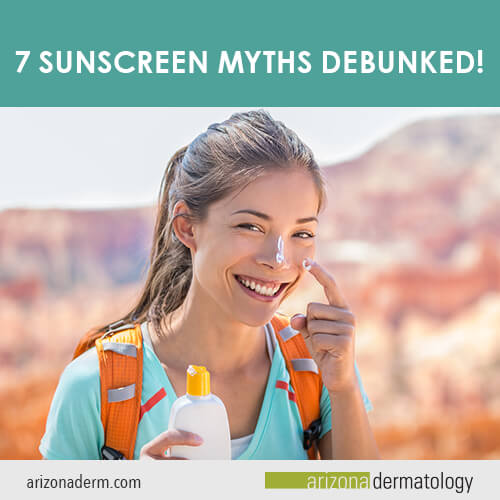 Got questions about sunscreen? You’re not alone. Let’s take a look at some of the top sunscreen myths and get the truth about sunscreen from a board certified dermatologist.
Got questions about sunscreen? You’re not alone. Let’s take a look at some of the top sunscreen myths and get the truth about sunscreen from a board certified dermatologist.
Myth #1: People with dark skin don’t need to wear sunscreen.
False. UV rays damage all types of skin! People with darker skin do have additional protection from the sun due to their skin’s melanin production, but they can still get a sunburn and they are still susceptible to the cellular damage that leads to skin cancer. In fact, while fewer people of color develop skin cancer, it is often diagnosed at a later stage when it is more dangerous, partly because of this myth! The bottom line: no matter your skin color, you still need to use a daily sunscreen with an SPF of 30 or higher and have regular skin checks.
Myth #2: Sunscreen causes cancer.
False. There is no scientific evidence that sunscreen causes cancer. However, there is plenty of evidence that UV exposure from the sun and tanning beds does.
Myth #3: Sunscreen disrupts natural hormone levels.
False. Claims have been made that a common chemical sunscreen ingredient, oxybenzone, may act as a hormone disruptor and interfere with the body’s natural hormone production. To date, there is no conclusive evidence of this. The claims are based on studies done on rats, where the rats ingested high quantities of oxybenzone. According to the Journal of the American Academy of Dermatology, it would take a person 277 years of sunscreen use to achieve the same systemic doses.
That said, if you want to avoid oxybenzone (which is also found in some plastics, hairsprays, and cosmetics), you can opt for a mineral sunscreen. Mineral sunscreens contain either titanium dioxide or zinc oxide as the main ingredients and work by reflecting UV rays rather than using chemicals to absorb them.
Myth #4: Waterproof sunscreens don’t need to be reapplied.
False. There is no such thing as a waterproof sunblock or sunscreen. The correct term is “water-resistant,” meaning that the product is formulated to last longer than other similar products when exposed to water or sweat, but it will eventually wash off just like any other sunscreen. No matter the marketing on the label, our dermatologists recommend that you reapply sunscreen every couple of hours under normal circumstances and every hour if you are swimming or sweating.
Myth #5: You don’t need sunscreen on a cloudy day.
False. Clouds block some, but not all, of the sun’s damaging ultraviolet rays. In fact, white clouds only block about 10% of UV radiation, and while gray clouds block more, many people ironically wind up getting a sunburn on a cloudy day because they think they don’t need to apply sunscreen! If you are skiing or at the beach on a cloudy day, you may be doubly exposed as the sun’s rays reflect off of snow and white sand. To protect yourself, use sunscreen every day, rain or shine.
Myth #6: Using sunscreen will put you at risk of Vitamin D deficiency.
False. Vitamin D is an important nutrient critical to bone health, so it makes sense that people might have a concern. That said, studies have found that normal sunscreen usage does not put people at risk of low Vitamin D levels for two reasons: first, sunscreens do not block 100% of UV rays and second, people do not apply sunscreen in the amounts and fashion necessary to affect Vitamin D levels. For people who are concerned about Vitamin D deficiency, our dermatologists recommend oral supplements which can help maintain healthy Vitamin D levels without raising the risk of skin cancer.
Myth #7: Using sunscreen every day means you’re protected from skin cancer.
False. Unfortunately, good sunscreen habits alone aren’t enough to protect you from developing skin cancer. Sunscreen does not block 100% of ultraviolet radiation and it’s unlikely you are applying it in exactly the necessary amounts, in exactly the necessary places, at exactly the right times to give you maximum protection. In addition to using sunscreen, our dermatologists recommend you take additional steps to protect yourself from UV exposure, like seeking shade and wearing sun protective clothing, especially during the hours of 10AM and 4PM.


